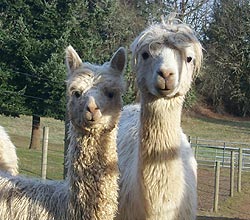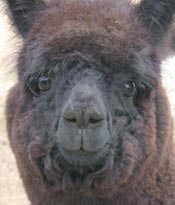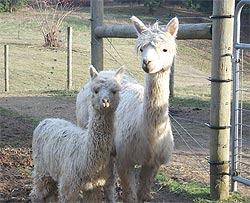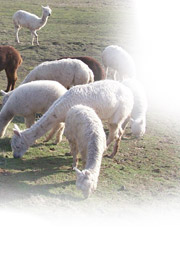About Alpacas

In their natural habitat of the high altitude regions of Peru, Chile and Bolivia, the Alpaca developed more thermal capacity in its fiber than any other animal. This is the ideal fiber for use by mankind and it is found on the gentle Alpaca.
Cherished by the ancient Incan civilization, Alpacas played a central role in their culture located on the high Andean plateau and mountains of South America. Alpacas have been domesticated for over 5,000 years and their popularity is only now becoming internationally recognized.
Spinners and weavers around the world now enjoy this cashmere-like fleece, once reserved for Incan royalty. Alpaca dyes easily and can be blended with wool, mohair, or silk.

The adult alpaca stands about 36 inches at the withers and weighs between 125 and 225 pounds. Alpacas are timid, yet curious and these herd-oriented animals live about 20 years. These animals adapt well to all climates are readily trained and easy to care for. They have padded feet with two toes instead of hooves making them gentle on the land. They efficiently convert grass and hay to energy, eating significantly less than most other livestock animals.
The Huacaya and the Suri are the two kinds of alpaca’s. With identical body types they appear distinctly different because of the unique fibers they produce. The Huacaya fiber is dense, crimpy, and wool-like. The fiber of the Suri hangs in locks and is straight and lustrous. Alpaca fiber grows continuously and is shorn once a year in the spring. Shearing can be done with hand shears or sheep-shearing equipment.
Alpacas prefer grazing and browsing in open pastures with seasonal supplementation of good quality hay, grain pellets and a mineral block are recommended. They require shelters for protection from the elements and fences are needed more to keep out predators than to keep the alpacas in. Occasional toenail trimming, vaccinations and regular parasite control encompass the majority of regular care. Alpaca herd care is not complicated and is both easy and fun.

Females can begin to breed at about 18 months of age, while males become ready to breed between 2 and 3 years. Alpacas are induced ovulators and are capable of breeding year round. Pregnancy is usually confirmed by use of one of several different tests. The alpaca gestation period is approximately eleven months usually resulting in one healthy baby called a cria. Most births occur during daytime and need no human assistance. Cria color is often a surprise and delight to both the experienced and the inexperienced alpaca breeder. Alpacas are devoted and protective mothers with weaning occurring at 4 to 6 months.
About us | About
Alpacas | Why Raise Alpacas? | Animals
For Sale | Stud Services | Visit Us
Alpaca Home | Bed & Breakfast | Alpaca
FAQ |
Our Baby Pictures | Alpaca
Links
Laughing Gargoyle Alpacas
26126 NW Russell Creek Rd. • Gaston,
OR 97119
Phone: 503-662-3016 • Fax: 503-662-4274
email: info@laughing-gargoyle.com
www.laughing-gargoyle.com

